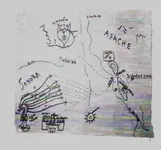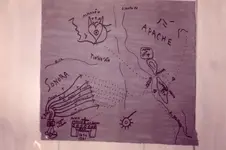gjb
Sr. Member
The story continues ...
They moored in a small bay off the headland, and Percy caught some of his father’s excitement, particularly as he kept impressing on him that he had to remember the place but tell nobody of its location. In the morning, they landed near the point of the headland and the men began searching for a free-standing rock - referenced on the back of the drawing - that had an arrow carved into it.
Percy lost interest after an hour or two, and it’s clear they didn’t have specific enough instructions to locate the required spot. The men eventually met on the beach to decide on a more structured plan of action.
They had the parchment plan with them and sat a while checking the view, and it certainly looked like they were in the right place, but there seemed to be no stone, as was mentioned on the reverse, along with further observations concerning the location sought. Having found the stone, according to the text, they had to locate three more points.
Percy had seen the instructions, but was not included in the discussions of his seniors, one of whom happened to be flipping the map in agitation. Percy noted that two of the points on the reverse (which just seemed like oversized bullet points in the text) seemed to be located on the edges of islands on the other side, and the third was below the leftmost. He suggested that maybe these points might pertain to the front, and might then provide a specific reference point.
When the marks were transferred to the image, and with the points connected, it appeared they’d been looking for the rock in the wrong place - and I could see exactly what Percy meant when flipping the map, which was fairly stiff. The writing on the back included three points marked as ‘blobs’. Two of these matched up with the edges of islands, and the third provided a possible viewing point. So, once in the bay, you could see from the blobs where you had to be in order to line the islands up in that particular way. Thus, the point they were looking for was in a line with the most eastward of the islands.
They walked a considerable way along the headland until they were at the spot that seemed to be suggested, that is, north of the east island, where the fourth island could be seen between the second and third.
Within thirty minutes they found the marker stone. It didn’t have an arrow cut into it, as described in the text, it had an anchor. It seemed to me they may have taken a leap of faith by simply assuming that this was a stratagem to put off any casual observer, except that the holder of the map would know the anchor was actually an arrow. In apparent confirmation, it pointed as a continuation of the line between the two islands. So, they now had to find the three points somewhere inland.
They followed the line uphill for a hundred yards or so through rocky and stony ground, maintaining a constant bearing from the islands, then continued over the crest and into trees - and completely lost their bearings. They were forced to return to the crest and figure out a way to continue the line on the other side of the hill. They did so with timbers and rock cairns, and some trust in their compass, but this proved unsatisfactory, and they called a meeting at the top of the hill.
They moored in a small bay off the headland, and Percy caught some of his father’s excitement, particularly as he kept impressing on him that he had to remember the place but tell nobody of its location. In the morning, they landed near the point of the headland and the men began searching for a free-standing rock - referenced on the back of the drawing - that had an arrow carved into it.
Percy lost interest after an hour or two, and it’s clear they didn’t have specific enough instructions to locate the required spot. The men eventually met on the beach to decide on a more structured plan of action.
They had the parchment plan with them and sat a while checking the view, and it certainly looked like they were in the right place, but there seemed to be no stone, as was mentioned on the reverse, along with further observations concerning the location sought. Having found the stone, according to the text, they had to locate three more points.
Percy had seen the instructions, but was not included in the discussions of his seniors, one of whom happened to be flipping the map in agitation. Percy noted that two of the points on the reverse (which just seemed like oversized bullet points in the text) seemed to be located on the edges of islands on the other side, and the third was below the leftmost. He suggested that maybe these points might pertain to the front, and might then provide a specific reference point.
When the marks were transferred to the image, and with the points connected, it appeared they’d been looking for the rock in the wrong place - and I could see exactly what Percy meant when flipping the map, which was fairly stiff. The writing on the back included three points marked as ‘blobs’. Two of these matched up with the edges of islands, and the third provided a possible viewing point. So, once in the bay, you could see from the blobs where you had to be in order to line the islands up in that particular way. Thus, the point they were looking for was in a line with the most eastward of the islands.
They walked a considerable way along the headland until they were at the spot that seemed to be suggested, that is, north of the east island, where the fourth island could be seen between the second and third.
Within thirty minutes they found the marker stone. It didn’t have an arrow cut into it, as described in the text, it had an anchor. It seemed to me they may have taken a leap of faith by simply assuming that this was a stratagem to put off any casual observer, except that the holder of the map would know the anchor was actually an arrow. In apparent confirmation, it pointed as a continuation of the line between the two islands. So, they now had to find the three points somewhere inland.
They followed the line uphill for a hundred yards or so through rocky and stony ground, maintaining a constant bearing from the islands, then continued over the crest and into trees - and completely lost their bearings. They were forced to return to the crest and figure out a way to continue the line on the other side of the hill. They did so with timbers and rock cairns, and some trust in their compass, but this proved unsatisfactory, and they called a meeting at the top of the hill.






 keep it coming!
keep it coming!